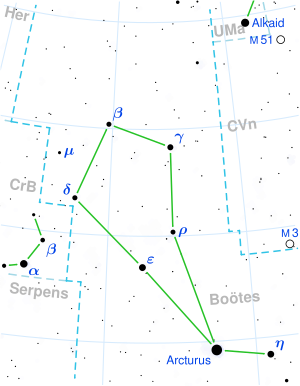astro.wikisort.org - Star
2MASS J15031961+2525196 (2MASS 1503+2525) is a nearby brown dwarf of spectral type T5.5,[5] located in the constellation of Boötes at approximately 20.7 light-years from Earth.[6]
| Observation data Epoch J2000[1] Equinox J2000[1] | |
|---|---|
| Constellation | Boötes |
| Right ascension | 15h 03m 19.613s[1] |
| Declination | 25° 25′ 19.68″[1] |
| Characteristics | |
| Spectral type | T5[2] |
| Astrometry | |
| Radial velocity (Rv) | 33±14[3] km/s |
| Proper motion (μ) | RA: 87.414±0.613[4] mas/yr Dec.: 557.780±0.695[4] mas/yr |
| Parallax (π) | 155.7758 ± 0.7557 mas[4] |
| Distance | 20.9 ± 0.1 ly (6.42 ± 0.03 pc) |
| Other designations | |
| Database references | |
| SIMBAD | data |
 2MASS 1503+2525 Location of 2MASS 1503+2525 in the constellation Boötes | |
History of observations
Discovery
2MASS 1503+2525 was discovered in 2003 by Adam J. Burgasser et al. in wide-field search for T dwarfs using the Two Micron All Sky Survey (2MASS).
Distance
Originally the most precise distance estimate of 2MASS 1503+2525 is a trigonometric parallax, published by Dupuy and Liu in 2012: 157.2 ± 2.2 mas, corresponding to a distance 6.36 ± 0.09 pc, or 20.7 ± 0.3 ly.[6] The parallax was further refined by Gaia mission in 2018 to 154.9208±1.1025mas. The brown dwarf 2MASS 1503+2525 lies in local void 6.5 parsecs across, where relatively few stars and brown dwarfs are located.[7]
Physical properties
The 2MASS J15031961+2525196 is the spectral standard of the spectral class T5.[8]
References
- "2MASS J15031961+2525196 -- Brown Dwarf (M<0.08solMass)". SIMBAD. Centre de données astronomiques de Strasbourg. Retrieved 2013-09-19.
- SURFACE GRAVITIES FOR 228 M, L, AND T DWARFS IN THE NIRSPEC BROWN DWARF SPECTROSCOPIC SURVEY, 2017, arXiv:1703.03811
- A BROWN DWARF CENSUS FROM THE SIMP SURVEY, 2016, arXiv:1607.06117
- Brown, A. G. A.; et al. (Gaia collaboration) (2021). "Gaia Early Data Release 3: Summary of the contents and survey properties". Astronomy & Astrophysics. 649: A1. arXiv:2012.01533. Bibcode:2021A&A...649A...1G. doi:10.1051/0004-6361/202039657. S2CID 227254300. (Erratum: doi:10.1051/0004-6361/202039657e). Gaia EDR3 record for this source at VizieR.
- Burgasser, Adam J.; Kirkpatrick, J. Davy; McElwain, Michael W.; Cutri, Roc M.; Burgasser, Albert J.; Skrutskie, Michael F. (2003). "The 2Mass Wide-Field T Dwarf Search. I. Discovery of a Bright T Dwarf within 10 Parsecs of the Sun". The Astronomical Journal. 125 (2): 850–857. arXiv:astro-ph/0211117. Bibcode:2003AJ....125..850B. doi:10.1086/345975. S2CID 15764829.
- Dupuy, Trent J.; Liu, Michael C. (2012). "The Hawaii Infrared Parallax Program. I. Ultracool Binaries and the L/T Transition". The Astrophysical Journal Supplement. 201 (2): 19. arXiv:1201.2465. Bibcode:2012ApJS..201...19D. doi:10.1088/0067-0049/201/2/19. S2CID 119256363.
- Bihain, G.; Scholz, R.-D. (2016), "A non-uniform distribution of the nearest brown dwarfs", Astronomy & Astrophysics, 589: A26, arXiv:1603.00714, doi:10.1051/0004-6361/201528007, S2CID 119102741
- NEW Y AND T DWARFS FROM WISE IDENTIFIED BY METHANE IMAGING, 2018, arXiv:1804.00362
На других языках
[de] 2MASS J15031961+2525196
2MASS J15031961+2525196 ist ein etwa 26 Lichtjahre von der Erde entfernter Brauner Zwerg der Spektralklasse T6 im Sternbild Bootes. Er wurde 2003 von Adam J. Burgasser et al. entdeckt. Seine Position verschiebt sich aufgrund seiner Eigenbewegung jährlich um 0,0226 Bogensekunden.- [en] 2MASS J15031961+2525196
Другой контент может иметь иную лицензию. Перед использованием материалов сайта WikiSort.org внимательно изучите правила лицензирования конкретных элементов наполнения сайта.
WikiSort.org - проект по пересортировке и дополнению контента Википедии